


 |
September 26, 2013: Sightseeing in Dublin, Ireland |
 |
September 24, 2013: Inisheer Island and the Cliffs of Moher |
 |
Return to the Index for Our British Isles Trip |
After breakfast this morning, we'll be saying good-bye to Maire and the Nile House Lodge and returning to Dublin. Before we leave, Nancy wants to do some shopping in the old city of Galway, so we will spend some time walking around there. Then we will drive back to Dublin and turn in our van at the airport, taking a taxi to our last lodging of the trip- the Ariel House. We'll do dinner in Dublin and, I hope, have a chance to walk around some.
A Morning Walk in Galway
|
When we exited the garage, we had to walk a block south out of the dead-end street we were in, turned right and walked along Abbeygate Street to High Street (the often-named "Main Street" in the British Isles). Along the way, Guy made a small donation, secure in the knowledge that his donation would stay right where he put it. Ron stuck his head into the barbershop we passed, but since he already had a haircut in Bristol, he didn't think he needed another one.
When we got to the corner of High Street and Abbeygate, we stopped to take stock of what everyone wanted to do. While they were in discussion, I took pictures looking upHigh Street and also looking down High Street towards the bay and the Spanish Arch where we'd been two nights previously. As it turned out, Nancy and Prudence and Guy wanted to look through a shop that was just a couple of doors up the street from the intersection, so they went in to have a look around.
For the next hour and a half, our group just wandered down the High Street, looking at all the stores and shops and the people; there was a lot to see. We did pass or stop at a few places worth mentioning, such as St. Nicholas Collegiate Church partway down the street and off to our right. This church is the largest medieval parish church in Ireland in continuous use as a place of worship. It was founded in 1320, dedicated (like many other European churches in seaports) to Saint Nicholas of Myra, the patron saint of seafarers. The church now belongs to the Church of Ireland.
|
|
It was once home to the Mayor of Galway, Thomas Lynch Fitz-Ambrose, until it was seized from him by Col. Peter Stubbers following the surrender of Galway to Cromwell's invading forces in 1653. Stubbers is thought to have been responsible for the beheading of King Charles I of England in 1649- hence the name of the establishment.
On our way down High Street, we passed the Claddagh Jewellers, and Fred took the picture because of the colorful mural painted on the building. I don't know what connection the beanstalk has to the jeweller, but I did investigate on the store's website.
|
The design and customs associated with the ring originated in the Irish fishing village of Claddagh, located just outside the old city walls of Galway, now part of Galway City. The ring, as currently known, was first produced in the 17th century. One odd factoid that I found was that, by all accounts, more than 200 such rings were found in the ruins of the World Trade Center. This would have meant that about one person in fifteen who died that day would have been wearing one.
We continued down High Street, intending to stop and wait at the foot of the street for Guy and the girls to catch up. We were going slowly, and only covering three blocks or so, so we weren't afraid of losing them.
|
Street Performer in Galway City |
The other group was a trio doing Irish music (Naturally. You expected Miley Cyrus?) using a bass, a banjo-like instrument and what I thought was a piccolo. You can see the piccolo player in Fred's picture and you can see the bass player in mine. It wasn't until I was reviewing the pictures to create this page that I noticed something in a picture fred had taken an hour earlier this morning. Have a look here and tell me if you see anyone familiar.
Below are clickable thumbnails for a few of Fred's pictures taken as we walked down High Street:
 |
Another interesting scene we passed was a street artist at work. From a distance, I thought he might be doing one of those "trompe d'oeil" chalk art things on the pavement, but when I got close I could see he was writing a poem on the stones. Another donation and I felt OK taking a picture of the poem.
|
 |
I thought that so many places on the High Street were so colorful that I would try my hand at the "single color" mode on my new little camera. This mode allows you to point the camera and select a particular color in the viewfinder; then, when you actually take the picture, only that color shows up, and everything else is in black and white. I tried a number of these, and three of them turned out well. There are clickable thumbnails below for more of our High Street pictures; the single-color shots are the rightmost three thumbnails:
 |
Towards the foot of High Street, in sight of the Spanish Arch, we came to a little side street called Druid Lane. Since we could see a couple of antique shops down this street to the north, we thought we would wait for everyone else here.
|
While they were doing that, Fred and I occupied ourselves taking a few pictures along the street and of the store windows (at one point violating a command not to do so); you can use the clickable thumbnails below to see these pictures (the violation is the middle thumbnail):
 |
Ron was hungry, and he noticed a little cafe that made traditional Irish pies (kind of like Southern meat pies over in Louisiana) so we wandered over to read the menu in the window. Liking what he saw, he went in to get one, along with some chips and a beer, and I went to keep him company. He gave me the last bite of his meat pie, and it was quite good. Stepping outside, Fred got our picture.
The last thing Nancy did was to go into another little antique shop just down from the Pie Maker, and I went in with her. She liked looking around, and when she was successful in her search, I snapped a picture of her buying a ring.
Our walk through Galway City was interesting; when we were finished, we walked back to the department store garage to reclaim our van and head back to Dublin.
Returning to Dublin
 |
We had driven perhaps two-thirds of the way to Dublin when we had to stop for gas, so we exited at the small town of Tyrrellspass. Tyrellspass is the modern name for Fartullagh, where in 1597 Captain Richard Tyrrell, a chief ally of Aodh Mór Ó Néill in the Nine Years War, won a major victory against English crown forces in what has become known as the Battle of Tyrrellspass.
|
The castle is about 60 feet high and follows the general pattern of tower houses, stone built, essentially defensive and comprising a series of superimposed chambers. The original spiral staircase and one of the original roof beams dating from 1280 can still be seen today. Alongside the entrance door is a murder-hole through which intruders could be attacked.
During the Cromwellian invasion of 1650, it is said the castle occupants suffered a great deal and many were executed. The castle and surrounding land was acquired soon after by the Rochfort family, who became the Earls of Belvedere. In 1796 the 2nd earl leased the castle to the army as a barracks. In 1850 ownership passed to Charles Brinsley Marlay, grandson of the 1st earl's only daughter, after whom it passed to LTC Charles Howard-Bury, the explorer. He sold off the houses on the estate.
After this tumultuous history, the castle was extensively restored by Phillip Ginnell in the 1970s, and in the early 1990s, was converted into a modern restaurant. Today it operates under the name Tyrrellspass Castle Restaurant and hosts medieval banquets. Here are one view each of the Castle from Guy, Fred and myself:
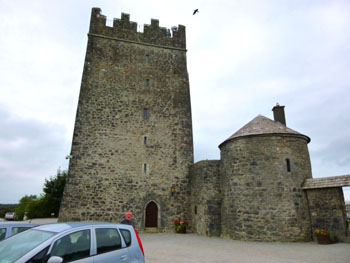 |
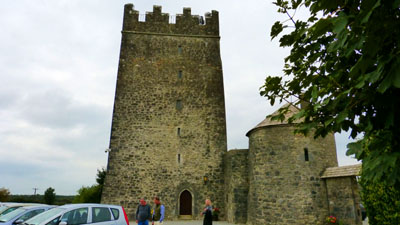 |
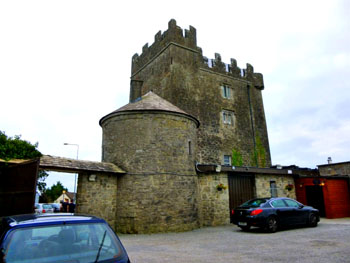 |
We ate at the restaurant, and had a nice, simple meal. When we were done, we went back out onto the road and headed off towards Dublin. I found the rental car place again easily, but due to construction around the airport had to take a circuitous route to actually bet back to it. After turning in the car, their shuttle took us back to the Dublin Airport where we called for a taxi large enough to carry all of us and our luggage. We got an extremely garroulous driver, and Ron and he hit it off during the thirty-minute trip to our next lodging- the Ariel House. When we got there, the driver gave us his card and Ron made arrangements with him to pick us up at 7AM the day after tomorrow to take us to the airport for our 10AM flight home.
If only it had been that simple.
The Ariel House
|
The only surprising thing was that breakfast was not included- something that had only been true at the hotels in Aberdeen and Liverpool and the Dylan Hotel here in Dublin. I suppose that this is common- hotels not offering the same breakfast that B&Bs do, but we just didn't know whether this guesthouse would. But that didn't really matter; we had some breakfast anyway each morning.
While the street that the Ariel House is on, Landsdowne Road, is a nice one, I was surprised to see, just a stone's throw from the guesthouse, the hulking presence of Aviva Stadium, a new construction in the last few years. Looking at the rounded roof of the structure from here, it looked for all the world like some huge alien spacecraft that had set itself down in the middle of Dublin. It was almost surreal.
I had intended to take pictures of our rooms and also make a movie here in the guesthouse, something I've done almost everywhere else, but events conspired to frustrate me. There was too little light this evening, and tomorrow turned out to be a grey, rainy day that was very, very busy with sightseeing. (The next day, knowing that the weather would be better on the day of our departure, I thought I would get up a bit early to take my pictures and a movie before we left for the airport. Little did I know that that plan would fail, too.) So here all you'll get are a couple of pictures and a description.
|
The houses were built in 1850, during the reign of Queen Victoria (1837 – 1901)- a time where Ireland was a constituent part of the United Kingdom. The main house was originally built for a wealthy merchant shipper and his family. From 1963 it ran as a small hotel, and the McKeown family took it over in 2002 and invested significantly in its restoration and renewal. Over the past decade they have sourced antique period furniture for many rooms, renovated original cornices, fireplaces and windows, and carefully selected fabrics, wallpapers and furniture that respects and enhances the original architecture. (That, as you can tell, comes from the Ariel House Web site.)
Features of the Victorian period include the bay windows, iron railings, Flemish brick bonding, stained glass windows, slate roofs and sash windows, all of which can be found in Ariel House. Ornate windows are a definite feature of the Victorian style. Also popular in the Victorian era was the use of contrasting brick colour to create patterns in the stone work, and this can be seen at its prettiest around the traditional Victorian entrance to Ariel House. (That also from their Web site.)
I can say that our room was certainly comfortable, although a bit small, and I think everyone else liked theirs.
When we were all settled in, we gathered on the front steps to talk with one of the desk clerks about local restaurants. Ron got some information about one he wanted to try, after which all of us headed off for an evening walk before dinner.
An Evening Walk in Dublin
|
On the map at right I have marked our route, labeling some of the stops we made.
But since we are back in civilization now, and Google Maps has 45° views for the city of Dublin, I'd like to use a mosaic that I built from some separate sections of the Maps site. It will show you our route as well, but you can actually see the buildings and things where we stopped or that we passed.
|
|
We left Ariel House and walked west on Landsdowne Road to Shelbourne Road where we turned north and walked along a quiet street of old Victorian homes until we came to the five-point intersection at Haddington Road. This is right in the center of an area of Dublin called Beggar's Bush. We turned left on Haddington and walked west, passing the entrance to the "Old Garrison Chapel." This group of former military buildings has been converted into a multi-use area, with offices and residences, and is the site of the Irish National Print Museum. You can see that entrance here.
We continued up Haddington to Northumberland and then, for no good reason turned right towards the center of town, passing more Victorian houses, a couple of which you can see here and here. After another block, the street crossed over what is called the Grand Canal. This waterway is the southernmost of a pair of canals that connect Dublin, in the east of Ireland, with the River Shannon in the west, via Tullamore and a number of other villages and towns, the two canals nearly encircling Dublin's inner city. Its sister canal on the north side of Dublin is the Royal Canal. The last working cargo barge passed through the Grand Canal in 1960.
We stopped here for a while, interested in the locks that were located here, wondering if they were still in use. Prudence got a nice picture of Nancy and Ron by one of the locks. We were just about to head on when a workman showed up and started messing with the locks. I made a couple of movies of what he was doing, and you can watch them with the players below:
|
The Workman at the Lower Lock |
Opening the Upper Lock |
I could only imagine that boats still came through here, but I couldn't figure out why he would be opening and closing the lock doors with no boat in sight.
|
 |
We still had almost two hours before our dinner reservation, which was at a place back at the five-point intersection we'd passed earlier. So we contined up the walk beside the canal, heading west, until we came to a side street that led towards the center of the city. We saw a church down that street, right in the middle of it, so we thought we would walk over and look at it.
Actually, we were approaching from the back of the church, so we had to walk to the other side of the square to have a look at it. St Stephen's Church is popularly known as "the Pepper Canister," and is the parish church for St. Stephen's Parish, part of the Church of Ireland. The church, situated on Upper Mount Street, was begun in 1821 by John Bowden and completed by Joseph Welland (1798-1860) after the former's death. The nickname derives from the shape of the spire. It was originally conceived as a chapel-of-ease for the parish of St. Peter's, which was the largest Church of Ireland parish in Dublin. Today the church is active both in faith activities and as a venue for musical and other events.
I didn't know it at the time but Fred had walked a short way down one of the side streets, and came back with a photo of an office building all lit up at the end of the day. I thought it interesting enough to include here.
Ron Ruckman thought we might just as well find a place to have some wine or a drink before dinner, so we headed back the way we'd come. When we got back to the locks, we found out why the workman had been messing with them:
 "There's a Boat in That Thair Lock!" |
If the picture looks a little odd, its because I had to take two pictures, change the perspective on one, and stitch them together. This little dinner cruise boat was coming down the canal- "down" being in the direction behind me, which leads to the Dublin harbor. There were no passengers on board, but the tables were all set, which led me to believe that the boat was being taken down to the harbor for its cruise; perhaps it is kept inland somewhere.
But it's what happened while we were here that was noteworthy; use the players below to watch the two movies and I'll explain:
|
We Arrive to Find a Boat Here |
After the Excitement |
If I wasn't clear in the movie, I had been standing down by the boat, just opposite the service cabin, when it started to lower. Obviously, it was being taken down the canal and under the bridge the others were standing on. After just a few seconds, I heard a noise from the other end of the boat, and could tell immediately that the end I was standing by was lowering while the other end was hung up on something. In a second or two I could hear glassware sliding off counters and wine bottles falling to the floor. This lasted just a few seconds when I heard another noise from the other end of the boat- something like splintering wood- and the whole boat settled back level again. I ran to the other end of the boat but didn't see any great damage, but there was a chunk of wood torn off the upper lock. So obviously the bow/stern of the boat had got hung up for a few seconds, and broke free when the weight became too great. I hope they got everything cleaned up before they got to the harbor!
We followed our same route back, and along Haddington, came by Ryan's Beggar's Bush pub and we stopped in. It was kind of like a sports bar, with a soccer game on the large TV. Ron had ale, I had a Bailey's and everyone else had wine while we relaxed for half an hour and enjoyed the ambience. Below are a couple of pictures I took inside the bar:
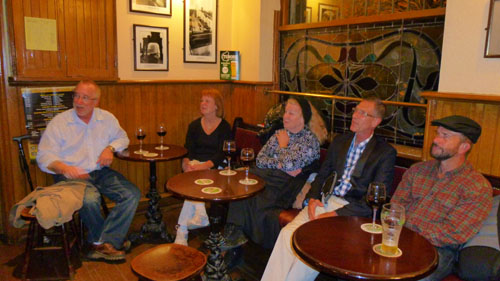 Inside Ryan's Beggar's Bush Pub |
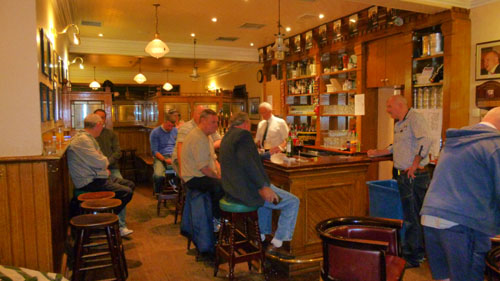 Inside Ryan's Beggar's Bush Pub |
When we'd finished our libations we all headed down toward the restaurant, but we still had some time to kill, so we stopped in at yet another bar right across the street from it. The ambience here was entirely different- young and fairly loud. Actually, I'm not sure if anyone had anything to drink here; I just know I didn't. About ten minutes before our reservation time, we went across the street to the restaurant.
Our table wasn't ready, so we had to stand off to the side waiting, and there was no good place to do that. It seemed as if we were always in someone's way. Our reservation time came and went, and after another twenty minutes of standing around and getting bumped and being in the way, I, myself, decided I wasn't hungry enough to put up with the gaff, so I told everyone else that I would just head back to the Ariel House to work on the day's email update. I ended up having some tea and cake in the lobby and eating some of the snacks I'd acquired in the previous few days. Two hours later, at about eleven, Fred came back. The food was good, he said, but the service was slow and surly and no one particularly enjoyed the dinner.
We both hoped the weather would be good tomorrow so we could see as much of Dublin as we could.
You can use the links below to continue to another photo album page.
 |
September 26, 2013: Sightseeing in Dublin, Ireland |
 |
September 24, 2013: Inisheer Island and the Cliffs of Moher |
 |
Return to the Index for Our British Isles Trip |